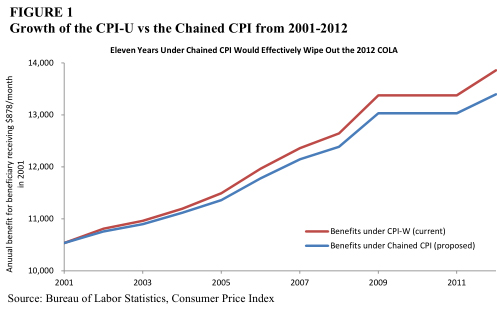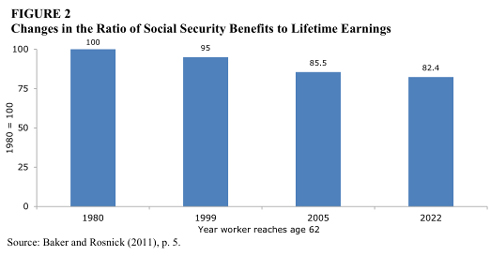August 07, 2013
August 7, 2013, Dean Baker
Thank you for the opportunity to comment on proposals to change the formula that determines benefit levels for Social Security to a relatively new measure, the Chained Consumer Price Index (CPI). Switching to the Chained CPI would save the federal government money by slowing increases in benefits and raising additional tax revenue, as most of the cost savings estimates assume that it would also be applied to other government programs as well as income tax brackets.
Proponents of these proposals argue that the Chained CPI is a more accurate formula and any impact on beneficiaries of the government programs affected would be mitigated by increased tax revenue from the wealthy. However, research and data effectively refute those arguments by showing that:
- Switching to the Chained CPI would result in cuts to already modest Social Security benefits.
- It is likely that the Chained CPI is not an accurate measure of the inflation rate seen by seniors.
- The Chained CPI would lead to income tax increases for working Americans.
Measuring Inflation
The Bureau of Labor Statistics (BLS) calculates the consumer price indexes to gauge inflation by measuring changes in the prices of goods and services that Americans purchase each month. In addition to being the basis for annual adjustments in benefits for government programs, changes in income tax brackets and deductions are also pegged to CPIs. Different indexes are used for different purposes. The CPI-U is used for income tax bracket calculation, while the CPI-W has been used to determine the yearly change in benefits for Social Security to keep pace with inflation since 1975.1
Some proposals advocate a change to the Chained CPI, which shows a lower rate of inflation than the currently-used CPIs. This index measures the price of a basket of goods whose items change in response to the relative price shifts of different goods, as opposed to the price baskets of the current CPIs, whose items remain fixed over time. An example of this would be a rise in the price of chicken leading people to buy less chicken and more cheese. The Chained CPI would then place a higher weight on the cheese component of its index and a lower weight on the chicken component. In essence, it substitutes in items with less rapid increases in price for items that have more rapid rises in price, thereby causing it show a lower overall rate of inflation.
The Chained CPI Would Result in Benefit Cuts for Retirees and Other Groups Dependent on Benefits
Social Security benefits are already quite modest. In 2012, the average annual benefit for beneficiaries aged 65 and older was less than $15,000.2 Any additional reduction of benefits would have serious repercussions for retirees, 2-out-of-5 of whom rely on Social Security for 90 percent of their retirement income.
The Chained CPI has been calculated as an official index by the BLS since 2002. It has shown an annual rate of inflation 0.3 percentage points lower on average than the current index used to calculate Social Security’s cost-of-living adjustment. Over time, changing to the Chained CPI would result in susbstantial cuts to Social Security benefits: a cut of roughly 3 percent after 10 years, about 6 percent after 20 years, and close to 9 percent after 30 years. In addition, lower- income retirees would lose much larger proportions of their income than wealthy ones.3
As shown in Figure 1, if the switch to the Chained CPI had been made in 2001, the reduction in benefits would have effectively wiped out the entire 2012 Social Security cost-of-living adjustment.4

Switching to the Chained CPI immediately would have a more significant impact on the retirement income of seniors than the ending the Bush-era tax cuts had on the after-tax income of the wealthiest 2 percent of households. For the average worker retiring at age 65, this would mean a cut of about $650 each year by age 75 and a cut of roughly $1,130 each year at age 85.5
These reductions in benefits would be a substantial hardship for millions of retired and disabled Americans.
Switching to the Chained CPI could also directly affect many other vulnerable Americans if it were applied to the other many federal assistance programs that rely on the current CPIs to determine eligibility for benefits. Just as the elderly would see their Social Security benefits cut by shifting to the Chained CPI, so would veterans, low-income children, the disabled, and others who are more likely to rely on government programs.
Accurately Calculating Cost-of-Living Adjustments for the Elderly
It is important to note that while some claim the Chained CPI more accurately calculates inflation, this is likely not the case for seniors, who would be directly affected by using the Chained CPI to calculate Social Security’s cost-of-living adjustments. The Bureau of Labor Statistics has found that seniors spend proportionally more of their income on medical care and housing, which in addition to rising more rapidly than most other costs, are also much harder to substitute with other products. This research suggests that a CPI based on living costs of the elderly would actually show a higher, not lower, rate of inflation. The BLS has constructed an experimental elderly index (CPI-E) that takes these factors into account, and it shows a rate of inflation that averages 0.3 percentage points higher than the CPI currently in use.6
In addition to there being fewer opportunities for substitution in these areas of consumption, because the elderly are a less mobile population, they may find it more difficult to change their consumption patterns. If accuracy is the main concern to be addressed by altering the Social Security cost-of-living adjustment, then the BLS could construct a full elderly index that more accurately tracks the consumption patterns of the elderly. There is no basis for assuming that a Chained CPI more accurately measures the rate of inflation experienced by the elderly than the current measure; however there is no doubt that it will lead to a reduction in benefits.
Some proponents of the Chained CPI argue that workers would respond to a reduction in Social Security benefits either by working later into life or saving more for retirement. In fact, in the 1990s there were a series of methodological changes to the CPI that reduced the measured rate of annual inflation by 0.5-0.7 percentage points. If the workers responded as argued, we would expect that non-Social Security income would be a larger portion of total income for beneficiaries in their mid-70s now (and therefore would have mostly been receiving the lower cost-of-living adjustment for a decade) than before when the CPI was changed. However, the data shows the opposite: the share of Social Security in retirement income increased rather than decreased in the vast majority of cases.7 This indicates that most workers did not save more to make up for lower Social Security benefits in order to counteract the CPI reduction. This is further proof that switching to the Chained CPI would lead to lower retirement incomes for elderly Americans.
This is of particular note as the rise in Social Security’s normal retirement age has already resulted in a decrease in benefits relative to lifetime earnings. The full-benefits retirement age increased from 65 to 66 between 2003 and 2008, and it is scheduled to rise further to 67 in steps from 2017 to 2022. These retirement age increases are cuts in benefits, since beneficiaries have to work more years before receiving them. Early retirees who begin collecting benefits at 62 between the years 2005-2016 are already seeing a decrease in benefits relative to lifetime earnings of 5 percentage points. For those retiring at 62 after 2022, when the retirement age reaches 67, the decrease in benefits will be 10 percentage points. Figure 2, below, illustrates the benefit cuts for these retirees as a result of the prior CPI changes and the scheduled increases in the eligibility age for full benefits.8 Adopting the Chained CPI would mean additional benefit cuts, further eroding the retirement security of Social Security beneficiaries.

A Tax Increase on the Middle Class
The Chained CPI would also effectively raise taxes on virtually all working Americans, especially middle and lower income families. By applying it to the annual adjustment in income tax brackets, the Chained CPI would cause those thresholds to rise more slowly than they do now. That would lead to incomes jumping up to higher tax brackets faster, or in other words, income tax increases.
According to Congress’ Joint Committee on Taxation, if individual income taxes were indexed to the Chained CPI starting in January 2013, by 2021, 69 percent of the gains in revenue would come from taxpayers with incomes below $100,000, while those in the highest income brackets would barely be affected. For example, workers with incomes between $10,000 and $20,000 would experience an increased tax burden of 14.5 percent, while those with incomes over $1,000,000 would just see an increase of 0.1 percent. 9 This contradicts the idea that the negative effects from benefit cuts due to a switch to the Chained CPI would be offset by increased revenue from the wealthy.
1 Social Security is indexed to the CPI-W (an index that tracks the consumption patterns of wage and clerical workers), while tax brackets and most other programs are indexed to the CPI-U (an index that tracks the consumption patterns of all urban households).
2 Social Security Administration. 2012. “Monthly Statistical Snapshot, October 2012.” http://www.ssa.gov/policy/docs/quickfacts/stat_snapshot
3 Baker, Dean and David Rosnick. 2010 “The Impact of Social Security Cuts on Retiree Income.” Washington, DC: Center for Economic and Policy Research. https://www.cepr.net/index.php/publications/reports/the-impact-of-social-security-cuts-on-retiree-income
4 CEPR Graphic Economics. 2011. “Eleven Years Under Chained CPI Would Effectively Wipe Out the 2012 COLA.” October 19. https://www.cepr.net/index.php/graphic-economics/graphic-economics/eleven-years-under-chained-cpi-would-effectively-wipe-out-the-2012-cola
5 Calculations based on 2012 Trustees report (http://www.ssa.gov/oact/tr/2012/index.html) if change is made from CPI-U to Chained CPI in January of 2013.
6 Stewart, Kenneth J. and Joseph Pavalone. 1996. “Attachment F: Experimental CPI for Americans 62 Years of Age and Older.” Washington, DC: Bureau of Labor Statistics. http://www.bls.gov/news.release/cpi.br12396.a06.htm
7 Baker, Dean and David Rosnick. 2011. “The Impact of Cutting Social Security Cost of Living Adjustments on the Living Standards of the Elderly.” Washington, DC: Center for Economic and Policy Research.
8 Ibid.
9 Barthold, Thomas A. 2011. “Memorandum: Revenue Estimate and Distributional Analysis.” Congress of the United States, Joint Committee on Taxation. June 29. http://democrats.waysandmeans.house.gov/sites/democrats.waysandmeans.house.gov/files/media/pdf/112/6-29ResponseChainedCPI.pdf






